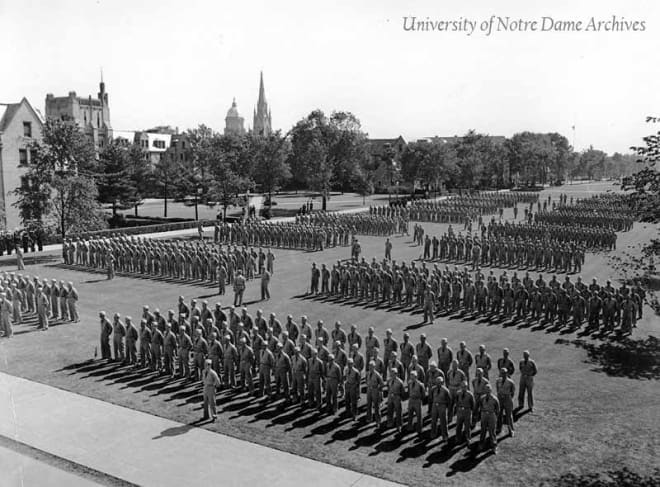Memorial Day Weekend: God, Country, Notre Dame, Part 2
Editor’s Note: The late, great Lou Somogyi possessed an unmatched knowledge of Notre Dame and it was his mission in life to share it with others. Those of us at BlueandGold.com would like to continue to share his wisdom and unique perspective with our readers.
Here is Part 2 of his annual Memorial Day series.
Engraved deep into the stone on the side door of the Basilica of Sacred Heart Church at Notre Dame are not merely words but a way of life: “God, Country, Notre Dame.”
It weaves together the school’s spiritual and patriotic elements while enjoining its loyal sons and daughters who are, as the Victory March states, “strong of heart and true to Her name.” The relationship between the military and Notre Dame goes far beyond football rivalries with Army, Navy and Air Force.
“Ever since 1858 when the student-organized Continental Cadets began marching across campus in their blue and buff American Revolutionary-style uniforms, Notre Dame has been teaching students how to be good soldiers,” wrote John Monczunski in the Spring 2001 Notre Dame Magazine.

Navy Saves Notre Dame From Sinking
While World War II raged in Europe during the early 1940s, Notre Dame was in need of better cash flow as a private school. Thus, school president Rev. Hugh O’Donnell C.S.C. offered the school’s facilities to the armed forces as a training ground.
The Army did not respond to O’Donnell’s invitation — but the Navy did. In September 1941, it established the Naval Reserve Officers Training Corps (NROTC) where approximately 150 Notre Dame students per year enrolled.
In early 1942, Notre Dame turned over four of its resident halls on the South Quad to the Navy for its V-7 program, which also was known as the Midshipmen’s School. During that transformation, the Navy constructed a drill hall and a headquarters/classroom building on the north side of the campus — where today’s Hesburgh Memorial Library is located.
With the United States fully engaged in World War II by 1943, the Navy needed more men to serve and it again teamed with Notre Dame to form the V-12 program. An estimated 12,000 officers completed their training at Notre Dame between 1942 and 1946.
“We were out of business during World War II,” noted 1952-87 Notre Dame president Rev. Theodore Hesburgh C.S.C., in a 1992 interview with the South Bend Tribune. “Navy came in and kept us afloat until the war was over.”
Hesburgh, whose original aspiration was to be a chaplain for the Navy when he took his vows in 1943, promised that under his watch the football series between the two schools would be kept as long as Navy wanted it continued.
The 1943 Irish national title football team included 14 Navy apprentice seamen, most notably sophomore quarterback John Lujack, who would win the 1947 Heisman Trophy, 12 transfers who were part of the Marine branch of the V-12, and 17 Marine privates — among them future College Football Hall of Fame inductees Ziggy Czarobski at right tackle, All-American right end John Yonakor, starting left guard Pat Filley and1943 Heisman Trophy winner Angelo Bertelli at quarterback.
All Gave Some; Some Gave All
Several members of the Irish 1940s dynasty won Purple Hearts: George Dickson (1949), who fought in Normandy on D-Day, Bob McBride (1941-42, 1946), a top assistant for head coach Frank Leahy after the war, Gus Cifelli (1946-49), and Luke Higgins (1942).
Awarded the Bronze Star for his reconnaissance work while swimming through underwater mines in the Pacific Ocean was future College Football Hall of Fame inductee “Jungle Jim” Martin, who never lost a game while he starred at Notre Dame from 1946-49.
Joining the military overseas in 1944-45 were head coach Leahy and top assistant Ed “Moose” Krause. It was Krause who recommended the move not just for service but credibility. The future 1949-81 Notre Dame athletics director noted to Leahy how once the war finished, the troops that returned to college on the GI bill would be hardened veterans of true war, not merely one on the gridiron. Respect for their coach(es) would be enhanced with the knowledge that they too were overseas.
Tragically, former Irish players who made the ultimate sacrifice in World War II included Jack Chevigny (1926-28), George Murphy (1940-42), Hercules Bereolos (1939-41), Harold Borer (1938), Frank Cusick (1942), Tom Creevy (1942) and Jack McGinnis (1942).
Many others who played earlier in their career (such as Chevigny), practiced as freshmen but never had a chance to play because of making the ultimate sacrifice, or were shipped overseas, include George Birmingham, Robert Callahan, Louis Curran, Ted Dorosh, Norb Ellrott, Allen Elward Jr., Vince Harrington, Wayne Johnston, John McGinnis, George Murphy, Martin O'Reilly and Howard Petschel.
Chevigny was the halfback who scored a touchdown in the famous “Win One For the Gipper” upset of Army in 1928, and served as an assistant for Rockne’s 1929 and 1930 national champs. The former head coach of Texas enlisted in the Army in 1943 at the advanced age of 37 and died in battle two years later in Iwo Jima, where the Marine Corps suffered 5,391 deaths during five weeks of fighting.
Weighing the tragic cost of a man's last full measure, "The Last Chalkline" is a true account and biography of Chevigny, a man who helped inspire what has become known as America's Greatest Generation.
----
• Learn more about our print and digital publication, Blue & Gold Illustrated.
• Watch our videos and subscribe to our YouTube channel.
• Sign up for Blue & Gold's news alerts and daily newsletter.
• Subscribe to our podcast on Apple Podcasts.
• Follow us on Twitter: @BGINews, @BGI_LouSomogyi, @Rivals_Singer, @PatrickEngel_ and @ToddBurlage.
• Like us on Facebook.
